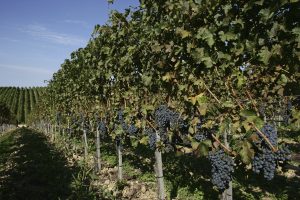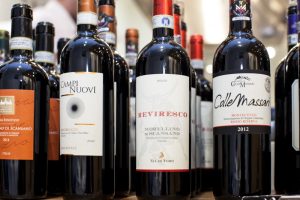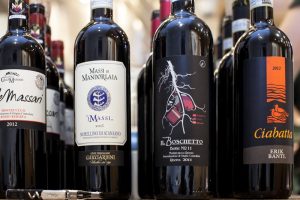

Maremma, located by the coast between the provinces of Livorno and Grosseto in Southern Tuscany, is known for its long stretches of sandy beaches, its rolling hills, and its natural thermal baths. It is also home to two D.O.C.G. wine producing regions: Montecucco and Morellino di Scansano.
Montecucco and Morellino di Scansano are neighbors, share ancient Etruscan and Romans roots, and produce Sangiovese wine. However, Sangioveses coming from these two regions differ considerably. Variations in the terroir, climate conditions and soil, as well as different approaches and styles to wine making within these two regions result in Sangioveses and other wines of different character and expression.
Sangiovese D.O.C.G., originating from the communes of Arcidosso, Capagnatico, Castel del Piano, Roccalbegna, Cinigiano, Civitella Paganico and Seggiano, and grown on the slopes of the Mount Amiata in Montecucco, benefit from the cool breezes coming off the Tyrrhenian Sea, the coast of the Monte Argentario peninsula, and Central Italy. These factors combine to moderate the temperature in these areas.

Mount Amiata also offers the communes protection against the elements while giving them access to considerable amounts of sunlight. It provides the region with mineral-rich volcanic soil. Furthermore, the location enjoys adequate rainfall and a good temperature range across seasons. These factors increase the potential for successful wine making. In addition, there are also the factors of centuries of wine production history, careful cultivation of vines, low yields, and the vineyard owners’ understanding of their land to consider. The winemakers in Maremma have all these things at their disposal and the results are wines that are considered some of the finest produced in Tuscany.
Rigorous regulations governing the production of Sangiovese Montecucco D.O.C.G. guarantee its quality. Montecucco wine must contain a minimum of ninety percent Sangiovese grapes to qualify for the D.O.C.G. The wine must also be aged for no less than twelve months in wood barrels followed by four months in the bottle. The minimum for the reserve increases to twenty four months of wood barrel aging followed by six months of bottle aging. The requirements for the Rosso and the D.O.C. decrease to a minimum of sixty percent Sangiovese grapes with no minimum wood aging requirement.

Some Montecucco wines to consider include a Campi Nuovi D.O.C., Sangiovese Montecucco, 2013 consisting of one hundred percent Sangiovese with wild cherry and dark fruit aromas, preserved plum and balsamic notes and balanced tannins.
Another fine choice includes a Castello Colle, Massari Montecucco, Rosso Riserva, 2012 comprised of eighty percent Sangiovese, ten percent Ciliegiolo and ten percent Cabernet Sauvignon, with ripe berry and sweet herb and balsamic aromas, chocolate and licorice notes and pronounced but balanced tannins.
Finally, there is a biodynamic and organic Basile, Ad Agio, 2011 consisting of one hundred percent Sangiovese with blackberry and black cherry aromas, ripe cherry and chocolate notes, and moderate tannins and acidity.
Scansano is located around the Southern Maremma coast, between the Ombrone Valley and the Albegna River. It is comprised of the territory of Scansano, and the municipalities of Grosseto, Magliano, Campagnatico, Roccalbegna, Semproniano and Manciano. Like Montecucco, Scansano benefits from sea breezes off the Tyrrenhian Sea, while the presence of hills provide the region with protection from seasonal winds. Choice areas along the hills within the region, offer good ventilation and plenty of sunlight, making them ideal for the cultivation of vines.
The Morellino di Scansano wine producing region was granted D.O.C.G. status in 2007. Sangiovese wines produced in this area consist of at least eight five percent Sangiovese grapes. International varietals such as Cabernet Sauvignon, Merlot and Syrah, as well as local Italian grape varieties including Canaiolo, Cilliegiolo, Malvasia, Colorino and Alicante, are often blended with the Sangiovese when making Morellino di Scansano.
Morellino di Scansano is meant to be enjoyed young. There is no minimum wood barrel or bottle aging requirement and the wine is released in the first year after vintage.
However, the reserve can only be released in the third year after vintage following a minimum of twelve months wood barrel aging and twelve months of bottle aging.
Another type of Morellino di Scansano is aged for four to twelve months. The style lies between that of the non-reserve and the reserve.

Some quality Morellino di Scansano wines include a Tenute Costa Terre di Fiori, Morellino di Scansano DOCG, 2013, comprised of vanilla and blackberry aromas, ripe cherry, dried dark fruit and strawberry preserve notes, and a soft finish.
Another good choice includes a Morellino di Scansano Vignaioli, Morellino di Scansano Vignabenefizio, 2014, consisting of ninety five percent Sangiovese and five percent Cabernet Sauvignon, with floral and preserved berry aromas, wild cherry, spice, chocolate and balsamic notes and an extended finish.

Be First to Comment